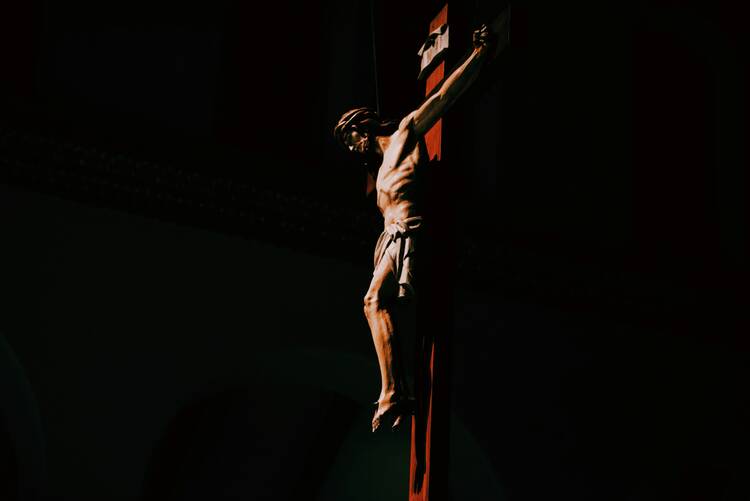A Reflection for Good Friday
Find today’s readings here.
After this, aware that everything was now finished,
in order that the Scripture might be fulfilled,
Jesus said, “I thirst.”
There was a vessel filled with common wine.
So they put a sponge soaked in wine on a sprig of hyssop
and put it up to his mouth.
When Jesus had taken the wine, he said,
“It is finished.”
And bowing his head, he handed over the spirit. (Jn 19:28-30)
Among the many complaints Friedrich Nietzsche had about Christianity—and the dude had a lot—was with the symbol of the cross. He wrote of it more than once, because he saw the valorization of Jesus’ excruciating death as part and parcel with Christianity’s larger project of undermining any people or culture that might take pride in strength, in domination, in achieving glory. Why, he asked, are so many people willingly walking around with a depiction of a Roman instrument of torture and humiliation around their necks?
He wasn’t the first, of course—already in the first century St. Paul was noting that the crucifixion of Jesus was “a stumbling block to the Jews and foolishness to the Greeks,” both because God should not become human in order to die and because being crucified was such a humiliating end for Jesus. He should have died like Socrates in The Phaedo, it seems, drinking a cup of hemlock and slipping away with dignity, surrounded by his friends and disciples. (Go ask a medical doctor sometime, by the way, what actually dying from hemlock poisoning is like.)
Jesuit missionaries to China in the 16th century encountered a similar difficulty with potential converts who, steeped in Confucian culture, could not understand why the Jesuits were so attached to an image that showed Christ in such an undignified and humble posture. This was Christ, the King of Heaven?
The temptation in such circumstances, I imagine, is just to pick another image—or at least to downplay the importance of crucifixion imagery—to proclaim the Good News. Jesus can be portrayed in many ways; salvation history has many images that convey important elements of the kerygma. And it’s any port in a storm, no?
Nah. It doesn’t work that way, methinks. We don’t get to Easter without Good Friday, without Holy Saturday. Jesus doesn’t rise on the third day in spite of the fact that he suffered, died and was buried; he rises because he suffered, died and was buried. It is not always a pleasant theology—certainly not one for the faint of heart—but I have a hard time seeing how Christianity makes any sense without it. Be nice to each other, as I was nice to you? Not today.
Today we focus on exactly what Nietzsche found so distasteful, what seemed so scandalous to the Greeks: the terrible reality of Christ crucified.
In his beautiful book Holy Land, D. J. Waldie recalls the Good Friday services of his youth, where he served as an altar boy. One by one, the congregation would come forth to venerate a crucifix, held up by the priest; many of them would kiss the feet of Jesus. Waldie’s job was to swoop in after each kiss, wiping away the lipstick and the germs. The whole service—music included, worked to allow every Christian in that space to say “Thank you for this,” I owe you my salvation. It doesn’t mean one has to accept every last jot or tittle of atonement theory, of course; but it does encourage contemplation of the bloody sacrifice.
Waldie also referenced in that memory an ancient hymn (no, seriously, it’s from the sixth century), the “Crux Fidelis,” that is part of the Good Friday service. Some of the Latin:
Dulce lignum, dulces clavos, dulce pondus sustinet
His telling of the scene has stuck with me ever since I first read that book (I looked it up—May 2000), because it spoke to what I think part of the commemoration of Good Friday is: A recognition that the cross is important, is necessary, is not an embarrassing detail in the story of Christ’s glory. We wear a crucifix, we kiss the feet of a statue, we sing songs about the crucifixion for a reason.
The English translation of the Latin above is this:
Sweet the wood, sweet the nails, Sweet the weight you bear.








